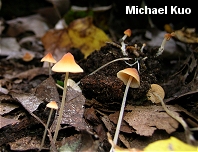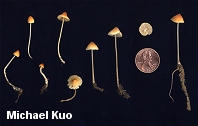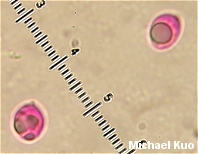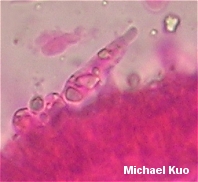| Major Groups > Gilled Mushrooms > Pale-Spored > Mycenoid Mushrooms > Mycena leptophylla |

|
Mycena leptophylla [ Basidiomycetes > Agaricales > Tricholomataceae > Mycena . . . ] by Michael Kuo Closely related to the better known Mycena adonis (and often conflated with it in field guide treatments), this tiny, beautiful mushroom grows on the ground in hardwood forests, usually in the vicinity of rotting wood. It features a bell-shaped to conical, yellow to dull orange cap, and a stem that often forms a tap root that burrows into the substrate. Under the microscope it has fairly inconspicuous, fusoid-ventricose cheilocystidia and nearly round spores. Mycena roseipallens, which also appears under hardwoods, is nearly identical but has more red in its cap color and features ellipsoid spores. Mycena adonis grows primarily on the debris of conifers and has a scarlet cap, along with different microscopic features. Description: Ecology: Saprobic on terrestrial forest debris in hardwood forests (and occasionally reported in conifer forests); usually growing gregariously but sometimes found growing scattered or even solitary; fall; apparently fairly widely distributed in eastern North America. Cap: Up to 2.5 cm across; conical to broadly conical or bell-shaped, often with a central nipple; moist when fresh; bald; dull orange, becoming orangish to yellowish over the center and whitish toward the margin; the margin lined. Gills: Attached to the stem by a tooth; close or nearly distant; whitish or pale pinkish to pale orangish. Stem: 3-7 cm long (above ground); 1-2 mm thick; fragile; equal; hollow; very finely silky, or bald; whitish to silvery grayish or very pale yellowish; basal mycelium hairy and white; often forming a tap root up to about 5 cm long. Flesh: Insubstantial; pallid or grayish. Odor and Taste: Odor not distinctive or very faintly mealy; taste not distinctive. Chemical Reactions: KOH negative on cap surface. Spore Print: White. Microscopic Features: Spores 6.5-8 x 4.5-7 µ; inamyloid; mostly ovoid to subglobose, but occasionally broadly ellipsoid or nearly amygdaliform; smooth. Basidia 2- or 4-spored. Cheilocystidia up to about 40 x 10 µ; fusoid-ventricose; only rarely branched. Pleurocystidia absent or very rare. Pileipellis a cutis, with the uppermost elements sparsely diverticulate. REFERENCES: Peck, 1872. (Saccardo, 1887; Smith, 1947; Moser, 1978; Hansen & Knudsen, 1992; McNeil, 2006.) Herb. Kuo 09280601. This site contains no information about the edibility or toxicity of mushrooms. |
© MushroomExpert.Com |
|
Cite this page as: Kuo, M. (2010, December). Mycena leptophylla. Retrieved from the MushroomExpert.Com Web site: http://www.mushroomexpert.com/mycena_leptophylla.html |




